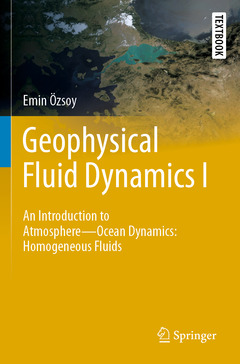Description
Geophysical Fluid Dynamics I, 1st ed. 2020
An Introduction to Atmosphere—Ocean Dynamics: Homogeneous Fluids
Springer Textbooks in Earth Sciences, Geography and Environment Series
Author: Özsoy Emin
Language: English
Subjects for Geophysical Fluid Dynamics I:
Publication date: 08-2021
287 p. · 15.5x23.5 cm · Paperback
Publication date: 01-2020
287 p. · 15.5x23.5 cm · Hardback
Description
/li>Contents
/li>Biography
/li>Comment
/li>
This textbook develops a fundamental understanding of geophysical fluid dynamics by providing a mathematical description of fluid properties, kinematics and dynamics as influenced by earth?s rotation. Its didactic value is based on elaborate treatment of basic principles, derived equations, exemplary solutions and their interpretation.
Both starting graduate students and experienced scientists can closely follow the mathematical development of the basic theory applied to the flow of uniform density fluids on a rotating earth, with (1) basic physics introducing the "novel" effects of rotation for flows on planetary scales, (2) simplified dynamics of shallow water and quasi-geostrophic theories applied to a variety of steady, unsteady flows and geophysical wave motions, demonstrating the restoring effects of Coriolis acceleration, earth?s curvature (beta) and topographic steering, (3) conservation of vorticity and energy at geophysical scales, and (4) specific applications to help demonstrate the ability to create and solve new problems in this very rich field. A comprehensive review of the complex geophysical flows of the ocean and the atmosphere is closely knitted with this basic description, intended to be developed further in the second volume that addresses density stratified geophysical fluid dynamics.
Emin Özsoy
Professor and head, Physical Oceanography
Professional:
1977-1978: Staff Engineer, Tetra Tech Inc., Jacksonville, FL, USA
1978-1983: Assistant Professor, IMS-METU
1983-1989: Associate Professor, IMS-METU
1989-present: Professor, Physical Oceanography Section, Institute of
Marine Sciences, METU, Erdemli, Mersin, Turkey
1989: Visiting scientist, IMGA-CNR, Modena, Italy
1989-1990: Visiting Professor, UNESCO and Fulbright Fellow, Harvard
University, Cambridge, MA, USA
2014-2015: Visiting Scientist, University of Bologna, Bologna, Italy
2015-2016: Visiting Scientist, EIES-ITU
Research Interests and Contributions:
• Ocean modeling / Levantine Basin of the Eastern Mediterranean, Black
Sea, Caspian Sea, Turkish Straits System
• Shelf seas – circulation, cascading flows / Cilician Basin, Black Sea shelf• Sea straits – dynamics, transport, modeling / Turkish Straits System
• Seas with islands /quasi-geostrophic dynamics
• Ecosystems /coupled hydrodynamics-ecosystem modeling• Double diffusive convection / Black Sea boundary and interior mixing
• Operational oceanography /observing systems, forecasting
• Atmospheric science / air-sea fluxes, dust transport, meteorologicalforecasting
• Oceanographic use of tracers / deep water renewal, transport
• Tidal inlets / tidal jet flows, sediment transport, morphology• Tsunamis / modeling Eastern Mediterranean tsunamis
• Climate variability and climate change / in the Seas of the Old World (e.g.
Black Sea, Mediterranean and Caspian Seas)• History of oceanography / 17th century work of Marsili in the Bosphorus
Projects:
- POEM Consortium - Physical Oceanography of the Eastern Mediterranean
- CoMSBlack Consortium – Black Sea
- Ventilation of the Black Sea – EU Copernicus Project- A




